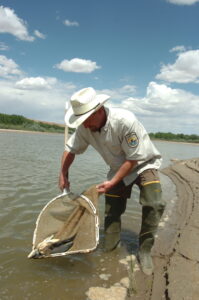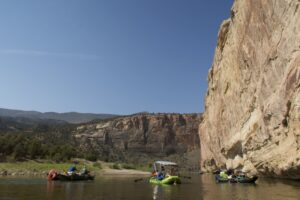How Colorado coal country could save the Yampa River
By Randy Rea
The Yampa River Basin is in trouble. Revered for its wild and unencumbered nature, the Yampa River starts high in the Flat Tops Wilderness at around 12,000 feet, flows down through the resort town of Steamboat Springs, Colorado, and meanders westward roughly two hundred and fifty miles to its confluence with the Green River in Dinosaur National Monument. It has mostly avoided major damming, making it a prized river for recreation, including fishing, white water rafting, kayaking, and more. The Yampa River also serves as a critical water source for industries like ranching, farming, and energy generation. Historically, the Yampa’s annual flows have been sufficient to satisfy all its users, but a twenty-two-year megadrought exacerbated by climate change has left the West drier than any time in the last 1,200 years. With temperatures increasing, snowpack decreasing, and soil moisture plummeting, people and industries reliant on the Yampa have had their headgates shut and their river rafts forced ashore.
Simultaneously, plans to close two coal-fired power plants in the Yampa River Basin have moved forward. In the face of growing political, social, and economic pressures, utility companies like Tri-State Energy Generation and Xcel Energy are making hard decisions to transition their energy generation portfolios away from coal and toward renewable assets. Over the next eight years, Craig Station and Hayden Station, stalwart employers of rural northwest Colorado, will systematically retire their power units. While these retirements will undoubtedly have a drastic impact on the rural communities whose citizens work at the power plants (and the local coal mines that provide the coal), the closures present an unprecedented opportunity for creative solutions to both water shortages and economic hardship in the Yampa River Basin.
While pursuing a joint law and master’s degree at the University of Wyoming College of Law and Haub School of Environment & Natural Resources, I have taken a hard look at the Yampa River and how Colorado water law can be used to bolster its stream flow and offer auxiliary benefits to local communities. The way I see it, the Yampa River Basin has two problems: first, it is losing its largest employers and bedrock economic industry; second, its river and riparian ecosystem is deteriorating rapidly. Coincidentally, the first problem may offer a solution to the second. These large, industrial employers consume tremendous volumes of Yampa River water, and soon will no longer need it. So how can the Yampa River make a comeback? How can the water that supported the energy industry for over fifty years be repurposed to support an evolving rural community and the environment? One possible answer is by transferring water rights from these coal-fired power plants back to the state in the form of instream-flow water rights.

Legally, a water right is a type of property right; you own the right to use the water like you own the right to use a piece of land. Collectively, Craig and Hayden station have water rights to consume approximately 21,000 acre-feet of water for energy generation each year. A single acre-foot is roughly 326,000 gallons and, for comparison, the entire city of Steamboat Springs consumes approximately 3,000 acre-feet of treated water annually. Colorado’s rivers and streams are governed by the prior appropriation doctrine, two pillars of which are “beneficial use” and “temporal priority.” Water rights are only legally recognized for certain, specified types of use that are considered “beneficial” (for example irrigation) and it matters when they are first granted. A common catch phrase for prior appropriation is, “first in time, first in right.” This means those who obtain a water right before others will have senior priority to the water. Craig Station’s water right dates back in priority to 1951; Hayden Station holds a very senior water right with a priority date of 1897. These senior water rights have more bite than a simple decree on paper. If a river’s flow is so diminished that there is less water in the river than there are water rights to fulfill, like the Yampa River today, the state will begin administering water diversions based on priority dates. Thus, senior water right holders will be able to divert and use their entire allotment of water before junior appropriators may take any water out of the river. It pays to be first.
Interestingly, a water right is not exclusive to out-of-stream water users. Colorado is a leader in the West for a legal concept called “instream-flow water rights.” Instream-flow rights grant a property right to the environment, meaning the state can designate a particular stream segment with a minimum volume of stream flow and attach a water right to it. Just like any other appropriator on a stream, an instream-flow water right is a legally protected property interest and subject to the same priority administration in times of low flow. Instream-flow water rights are unique because they expand the definition of “beneficial use” beyond diversion, to include keeping water in the stream for environmental conservation. The General Assembly first authorized the Colorado Water Conservation Board to appropriate water rights for instream-flows in 1973, in order to protect the environment and conserve waters of the state. Since passing the Instream Flow Act, Colorado has protected 1,684 stream segments covering 9,720 miles of stream and 482 natural lakes.

For the Yampa River, an instream-flow water right could not only protect the river but also maintain the necessary water levels for four native fish species listed as endangered by the U.S. Fish and Wildlife Service: Colorado pikeminnow, razorback sucker, bonytail chub, and humpback chub. Punctuated by rushing, high-flow snowmelt from April to June, the Yampa River distributes nutrients and sediment and physically rearranges cobble bars and river banks, making suitable eddies and channels for spawning and rearing young fish. These type of flows make the Yampa one of the most important tributaries in the Upper Colorado River Basin for the recovery of these species. When flows are reduced, cascading effects disturb and diminish important recovery habitat.
Meanwhile, the rural communities along the Yampa River’s banks are set for a large economic down-turn. In Craig, Tri-State Energy Generation and Colowyo provide over $9 million in tax revenue and hundreds of high-paying jobs to the local residents. These business work in unison; Colowyo coal mine provides the coal that Tri-State burns to generate electricity. The tax revenues they provide are critical to support the school district, fire district, and other Moffat County municipal government functions, but when Craig Station shuts down, so too goes the tax revenue. While Tri-State is making significant investments in the community to aid in the transition, few things can replace such a singularly important economic pillar. More than likely, these towns will need to rely at least in part on the Yampa River and the intrinsic value of their natural landscapes to draw recreation tourism and community investments. An instream-flow water right on the Yampa could protect the area’s natural value and preserve the conditions needed for recreation like rafting, fishing, and kayaking.

So, how would it work? The Colorado instream-flow statutes establish clear and flexible options for transferring water rights for environmental purposes. While all instream-flow rights must be administered by the Colorado Water Conservation Board, the Colorado Water Trust (CWT) is a statewide non-profit dedicated to ushering transfers of existing water rights back to the environment. In over twenty years the CWT has restored 13.5 billion gallons of water to 588 miles of rivers and streams throughout the state and, if this option lifts off, the CWT could take the lead. A permanent water right transfer requires a formal application to the Colorado water court and the CWT is versed in making transitions seamless.
Even if the details of a formal transfer could not be worked out by the time the plants officially shutdown, Colorado statutes allow for temporary, informal transfers through water right leases. This option could allow the stakeholders of each plant to generate revenue to aid in the transition process and provide vast volumes of water back to the Yampa during the lease, while continuing to weigh their long-term options.
While a transfer of water rights to instream-flows would provide a windfall of needed water to the Yampa, it may not be the most likely of options. First is the issue of funding. The Colorado Water Conservation Board is earmarked an annual budget of $1 million to acquire new instream-flow water rights, but it is not enough to complete an unprecedented, bona fide purchase of the Craig and Hayden Station water rights, which are potentially worth more than $100 million. An upfront purchase would require alternative funding sources, such as Great Outdoors Colorado, the Colorado Conservation Trust Fund, non-profits dedicated to the conservation of rivers, or additional Colorado General Assembly appropriations.
Additionally, there are many other competing entities for water in the region, like Colorado’s front range cities. Pumping water from the Yampa back over the Continental Divide has been proposed before and fought down multiple times. However, with the front range’s ever-growing demand, this may be an inevitable solution to quenching the greater Denver metro area. Another viable option would be for the Hayden and Craig Station owners to sell and transfer their water rights to another entity in the energy industry, like nuclear or hydrogen energy generation. These forms of energy generation technology are gaining steam in the region and require just as much water as coal-based energy generation. While these options may serve economic purposes for each plant’s respective stakeholders, they fail to recognize the Yampa River is dying for more water.
The West is in an unprecedented time. Water, not only in the Yampa River Basin, but also the broader Colorado River Basin, is in severe decline and every drop counts. Because no person can create more water, we must be willing to think outside of the box as to how water is divvied up. While it might be a long-shot, the retirement of coal-fired power plants possessing massive water rights provides such an opportunity. Craig Station and Hayden Station are just two of several coal-fired power plants in the Colorado River Basin facing retirement, and can serve as important case studies to alleviate the pressures on the very rivers and streams they have relied on for decades. The Yampa provided water to make their businesses possible, perhaps it is just to return that water at a time when the river desperately needs it.
Randy Rea is life-long admirer of the Colorado River. Growing up in the lower basin he vacationed just above Imperial Dam; now living in the upper basin, he has developed a passion for the river’s headwaters. Randy holds a J.D. and M.A. from the University of Wyoming with a focus on water law and water right transfers.



Pingback: Editor’s Note – Western Confluence